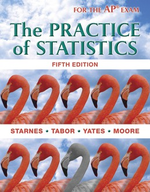A quiz question gives random samples of n = 10 observations from each of two Normally
Chapter 10, Problem t10.4(choose chapter or problem)
A quiz question gives random samples of n = 10 observations from each of two Normally distributed populations. Tom uses a table of t distribution critical values and 9 degrees of freedom to calculate a 95% confidence interval for the difference in the two population means. Janelle uses her calculators two-sample t interval with 16.87 degrees of freedom to compute the 95% confidence interval. Assume that both students calculate the intervals correctly. Which of the following is true? (a) Toms confidence interval is wider. (b) Janelles confidence interval is wider. (c) Both confidence intervals are the same. (d) There is insufficient information to determine which confidence interval is wider. (e) Janelle made a mistake; degrees of freedom has to be a whole number
Unfortunately, we don't have that question answered yet. But you can get it answered in just 5 hours by Logging in or Becoming a subscriber.
Becoming a subscriber
Or look for another answer
